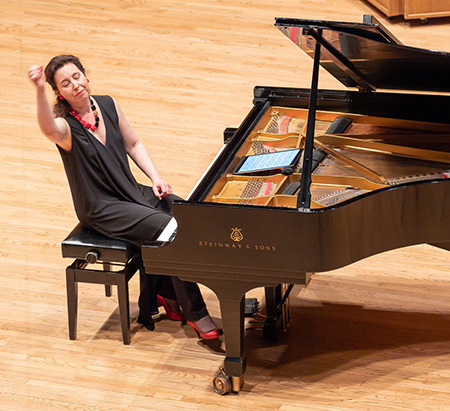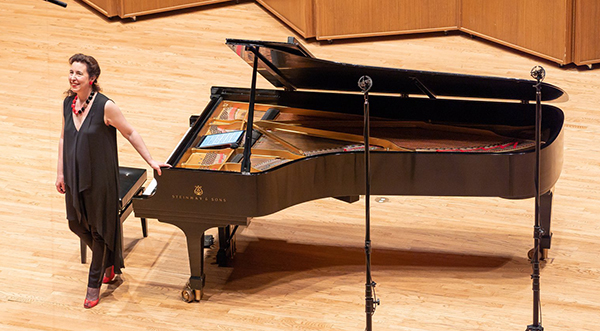by Timothy Robson

Although Hewitt has a vast repertoire, she is particularly renowned for her performances of the keyboard music of Johann Sebastian Bach. She is in the midst of a multi-year project, “The Bach Odyssey,” in which she is performing Bach’s complete keyboard works in five cities around the world.
Hewitt’s selections for this program emphasized the “Frenchness” of that most German of composers. It is clear that Bach was well aware of musical trends elsewhere in Europe. He also composed these “international” works as pedagogical pieces for his sons. The heart of the program consisted of three of his English Suites (No. 1 in A, BWV 806, No. 2 in a, BWV 807, and No. 3 in g, BWV 808), plus an unfinished Suite in f, BWV 823, and the large Prelude and Fugue in a, BWV 894. In spoken comments, Hewitt pointed out that “English Suite” is a misnomer. Instead, these are standard suites of French dances (Allemande, Courante, Sarabande, Bourée, Gigue) with appended preludes.
Hewitt’s playing was characterized by extraordinary clarity, flexible phrasing, and very subtle use of rubato. She placed slight emphasis on significant notes, marking harmonic signposts along the progress of the movements. The musical line constantly ebbed and flowed, and there was nothing pedantic about her ornamentation, which was gracefully incorporated into phrases. In illustrating the French influence on the English Suites, in several instances Hewitt used notes inégales.
The dance movements are mostly in two parts, each repeated. Hewitt’s repeats sometimes included more elaborate ornamentation, sometimes not. Occasionally in lieu of more ornaments, Hewitt slightly altered her articulation of phrases. In the third suite, Bach provided an alternative version of the Sarabande with elaborate written-out ornamentation. Hewitt first played the plainer version with repeats, followed by Bach’s ornamented version without repeats. The pianist used the damper pedal, but always discreetly.
The f-minor Suite has only three movements: Prelude, Sarabande, and Gigue. The Prelude was especially interesting for one passage repeated several times, separated by different material. The suite made an excellent opener for the second half of the program.
The concert closed with the a-minor Prelude and Fugue that Bach partially recycled for his Triple Concerto, BWV 1044. It is a relentless masterpiece, with page after page of triplet figures alternating with duple rhythms, and several written-out cadenzas. The long fugue subject is also based on a series of triplets. The brilliant musicianship that Hewitt had shown in the rest of the program was put to the test in this showpiece, which was an appropriate conclusion to an extraordinary concert.
As an encore Hewitt played a short, gentle movement from one of Jean-Philippe Rameau’s harpsichord suites, in tribute to the influence Rameau and his contemporaries had on Johann Sebastian Bach.
Published on ClevelandClassical.com May 21, 2019.
Click here for a printable copy of this article




